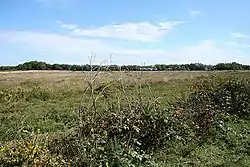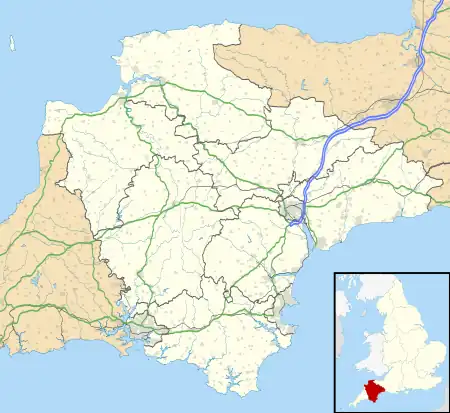Rackenford and Knowstone Moors
Rackenford and Knowstone Moors is a nature reserve of the Devon Wildlife Trust, situated about 8 miles (13 km) north-west of Tiverton, in Devon, England. The habitat is culm grassland.
| Rackenford and Knowstone Moors | |
|---|---|
 Looking south-east on Knowstone Outer Moor | |
 Location in Devon | |
| Location | near Tiverton, Devon |
| OS grid | SS 851 211 |
| Coordinates | 50°58′40″N 3°38′17″W |
| Area | 122 hectares (300 acres) |
| Operated by | Devon Wildlife Trust |
| Designation | Site of Special Scientific Interest Special Area of Conservation |
| Website | www |
Description
The reserve is a Site of Special Scientific Interest[1] and a Special Area of Conservation. Its area is 122 hectares (300 acres).[2]
Culm grassland is found in poorly drained lowland areas of acidic soil where there is high rainfall. The vegetation includes abundant purple moor grass and sharp-flowered rush.[2][3]
Over the last century, over 90% of culm grassland has been lost. The remaining parts are mostly in fragmented areas in north Devon; the most extensive fragment is this reserve. The Trust endeavours to protect, re-establish and link together isolated sites of culm grassland. In the reserve there is light grazing by cattle and deer; the low-intensity land management, little changed from prehistoric times, allows a wide diversity of plant species.[2]
Species
In the wetter areas, besides purple moor grass and sharp-flowered rush, species include ragged-robin, meadowsweet and wild angelica; in waterlogged areas there is sphagnum moss and sundew. In dry areas there is saw-wort, thistles and heathers. The plants support many species of butterflies, such as small pearl-bordered fritillary, marbled white and dingy skipper; birds including curlew, snipe and reed bunting may be found.[2]
Prehistoric site
On Knowstone Inner Moor there is saucer barrow, of the early Bronze Age: it is a mound, diameter 5.7 metres (19 ft) and height up to 1 metre (3 ft 3 in), surrounded by a ditch and outer bank.[4]
References
- "Hare's Down, Knowstone & Rackenford Moors SSSI" Natural England. Retrieved 12 November 2021.
- "Rackenford and Knowstone Moors" Devon Wildlife Trust. Retrieved 12 November 2021.
- "Purple moor grass and rush pastures (culm grassland - Devon and Cornwall)" Buglife. Retrieved 14 November 2021.
- Historic England. "Saucer barrow 100m south west of Knowstone Moor Cross (1017141)". National Heritage List for England. Retrieved 12 November 2021.
External links
- Rackenford and Knowstone Moors leaflet of Devon Wildlife Trust
- "Culm Grassland Natural Flood Management Project" Devon Wildlife Trust